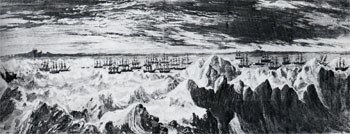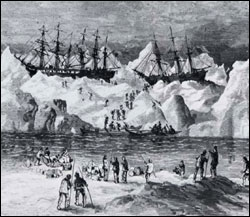|
The Disaster of 1871: The Ice Takes its Toll
 |
|
Whaling Fleet Trapped by the Ice, from Harpers Weekly (Bockstoce 1986)
|
32 Whaling Ships, more than 1200 men, trapped in the Ice off the Arctic coast of Alaska...
In August 1871, 32 whaling ships from Hawaii, New England, and California had come to the icy waters of the Arctic in the pursuit of the bowhead whale. The pack ice being close to shore that year left little room for maneuvering of the fleet but whales were relatively plentiful, and while there are whales to catch, the whaleboats go off to hunt. The whaling captains counted on a wind shift from the east to drive the pack out to sea as it had always done in years past. Instead of moving offshore, the ice pack suddenly and unexpectedly trapped all 32 ships between ice and shore in a constantly and quickly diminishing lead in the ice with no chance to escape to open water. The captains conferred, crafted a joint declaration describing the reasons for the abandonment, unanimously approved and signed the declaration, then began the very treacherous process to evacuate all 1219 men, women and children by way of the ships' whaleboats. In these frail craft the ships' crews rowed 90 miles south past Icy Cape where they were rescued by seven other whaling ships whose captains and crews gave up what was likely to be their own very lucrative whaling season to ferry the survivors to safety. Although the journey in the whaleboats required them to row through ice choked and heavy seas, not one life was lost. Of all the ships abandoned to the Arctic winter of 1871, only one ever sailed again. The remaining 31 vessels were crushed by the ice and sunk or burned after they were abandoned.
 |
|
Abandoning the George, Gay Head, and Concordia off Point Belcher from Harpers Weekly (Bockstoce 1986)
|
The Captains' decision to abandon the whaling ships was clearly documented in the declaration they had all written and signed, but the wisdom of not waiting longer to determine if a new lead would open was questioned. While later reports said the winds had changed and the ice blown offshore about two weeks after the ships had been abandoned, the risk involved in moving the crews to the shore and waiting would have been significant, given that few of the ships were prepared for such a contingency, and many of the ships were stove by ice and sunk as they were being abandoned. The lack of the loss of one crew member during this disaster was justification enough for the decision.
The economic blow to the whaling industry was staggering. Loss of the ships and cargoes was estimated at a value of $1.6 million ($22.5 million in 2000 dollars). This loss was most keenly felt in New Bedford, which was home port for 22 of the ships lost that year. Interestingly, however, few of these ships were replaced in the fleet, and most of the insurance paid to the whaling companies was reportedly invested in other industries, evidence of the beginning of the end of Yankee whaling.
|